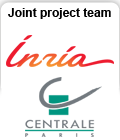Design of complex systems
The design of a complex (mechanical) system such as aircraft, automobile or nuclear plant involves numerical simulation of several interacting physical phenomena: CFD and structural dynamics, thermal evolution of a fluid circulation. Uncertainty processing in a multi-physical and multi-level modelling necessarily implies a large range of issues.
We focus on the following three axes:
- In the case of a phenomenon represented by two coupled partial differential equations whose resolution is represented by reduced-order models, how to define a probabilistic model of the coupling errors? In connection with our theoretical developments, we plan to characterize the regularity of this error in order to quantify its distribution. This research axis is supported by an ANR grant (OPUS project).
- Some fine characteristics of the phenomenological model may be used to define the probabilistic behaviour of its variability. In particular, the Hölder regularity is an important parameter for interpolation or approximation issues. Stochastic processes with prescribed regularity have already been used to represent various fluctuating phenomena: Internet traffic, financial data, ocean floor. We believe that these models should be relevant to describe solutions of PDE perturbed by uncertain (random) coefficients or limit conditions. This research axis is supported by a Pôle SYSTEM@TIC grant (CSDL project).
- A multi-level modelling assumes the ability to choose the right level of details for the models in adequacy to the goals of the study. In that view, a rigorous definition of the notion of model granularity would be very helpful. Again, a precise analysis of the fine regularity of stochastic models is expected to give elements toward a precise definition of granularity. This research axis is supported by a a Pôle SYSTEM@TIC grant (EHPOC project), and also by a collaboration with EADS.



